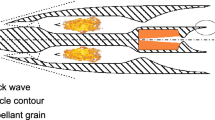Abstract
Calculations of the three-dimensional boundary layer in an S shaped duct are performed with various κ − ε models. Three different near-wall models are used for the κ − ε model, of which one is using a new set of near-wall damping functions deduced from direct numerical simulations of turbulent channel flow available in the literature. The results show that it is possible to obtain damping functions giving better agreement, especially for κ and ε, with direct simulation data and experiments than with damping functions deduced from trial and error.
Similar content being viewed by others
References
Alfredsson, P.H., Johansson, A.V., Haritonidis, J.H. and Eckelmann, H., The fluctuating wall-shear stress and the velocity field in the viscous sublayer.Physics of Fluids 31 (1988) 1026–1033.
Brunet, M. and Truong, T.V., Test case T1: Boundary layer in a “S”-shaped channel. In Pironneau, O., Rodi, W., Ryhming, I.L., Savill, A.M. and Truong, T.V. (eds),Numerical Simulations of Unsteady Flows and Transition to Turbulence. Cambridge University Press (1992).
Chen, H.C., and Patel, V.C., Near-wall turbulence models for complex flows including separation.AIAA Journal 26 (1988) 641–648.
Gavrilakis, S., Numerical simulation of low Reynolds number turbulent flow through a straight square duct.Journal of Fluid Mechanics 244 (1992) 101–129.
Johansson, A.V. and Alfredsson, P.H., On the structure of turbulent channel flow.Journal of Fluid Mechanics 122 (1982) 295–314.
Kim, J., Moin, P. and Moser, R., Turbulence statistics in fully developed channel flow at low Reynolds number.Journal of Fluid Mechanics 177 (1987) 133–166.
Lai, Y.G., an So, R.M.C., On near-wall turbulenceJournal of Fluid Mechanics 221 (1990) 641–673.
Lam, C.K.G. and Bremhorst, K., A modified form of the k–e model for predicting wall turbulence. Transactions of the ASME,Journal of Fluids Engineering 103 (1981) 456–460.
Lindberg, P.-Å., Near-wall turbulence models for 3D boundary layers. Internal report no T-91-9, IMHEF-DME. Ecole Polytechnique Federale de Lausanne, CH-1015 Lausanne, Switzerland (1991).
Lindberg, P.-Å., An anisotropic eddy viscosity model, using thek — ε model or an extended Johnson & King model for solving the boundary layer equations. In Pironneau, O., Rodi, W., Ryhming, I.L., Savill, A.M. and Truong, T.V. (eds),Numerical Simulations of Unsteady Flows and Transition to Turbulence. Cambridge University Press (1992).
Mansour, N.N., The use of direct numerical simulation data in turbulence modeling. AIIA paper 91–0221 (1991).
Mansour, N.N., Kim, J. and Moin, P., Reynolds-stress and dissipation-rate budgets in a turbulent channel flow.Journal of Fluid Mechanics 194 (1988), 15–44.
Moin, P., Shih, T.-H., Driver, D. and Mansour, N.N., Direct numerical simulation of a three-dimensional turbulent boundary layer.Physics of Fluids A (1990) 1846–1853.
Norris, L.H. and Reynolds, W.C., Turbulent channel flow with a moving wavy boundary. Rept. No FM-10, Stanford University, Dept. Mech. Eng. (1975).
Patel, V.C., Rodi, W. and Scheuerer, G., Turbulence models for near-wall and low Reynolds number flows: A review.AIAA Journal 23 (1985) 1308–1319.
Pollard, A. and Martinuzzi, R., Comparative study of turbulence models in predicting turbulent pipe flow. Part II: Reynolds stress andk — ε models.AIAA Journal 27 (1989) 1714–1721.
Rodi, W., Some current approaches in turbulence modelling. AGARD Technical status review on “Appraisal of the suitability of turbulence models in flow calculations” (1990).
Rodi, W. and Mansour, N.N., One-equation near-wall turbulence modeling with the aid of direct simulation data. InProceedings of the Summer Program 1990. Center for turbulence research, Stanford University (1990).
Rodi, W. and Mansour, N.N., Low Reynolds numberk — ε modeling with the aid of direct simulation data.Journal of Fluid Mechanics 250 (1993) 509–519.
Ryhming, I.L., Truong, T.V., Lindberg, P.Å., Summary and conclusions for the test case T1. In Pironneau, O., Rodi, W., Ryhming, I.L., Savill, A.M. and Truong, T.V. (eds),Numerical Simulations of Unsteady Flows and Transition to Turbulence, Cambridge University Press (1992).
Spalart, P.R., Direct simulation of a turbulent boundary layer up toR θ=1410.Journal of Fluid Mechanics 187 (1988) 61–98.
Speziale, C.G., Abid, R. and Anderson, E.C., A critical evaluation of two-equation models for near wall turbulence. ICASE Report No 90-46, ICASE, NASA Langley Research Center, Hampton, Virginia 23665-5225. USA (1990).
Truong, T.V., and Brunet, M., Test case T1: Boundary layer in an “S”-shaped channel. In Pironneau, O., Rodi, W., Ryhming, I.L., Savill, A.M. and Truong, T.V. (eds),Numerical Simulations of Unsteady Flows and Transition to Turbulence. Cambridge University Press (1992).
Author information
Authors and Affiliations
Rights and permissions
About this article
Cite this article
Lindberg, P.Å. Near-wall turbulence models for 3D boundary layers. Appl. Sci. Res. 53, 139–162 (1994). https://doi.org/10.1007/BF00849652
Received:
Accepted:
Issue Date:
DOI: https://doi.org/10.1007/BF00849652




